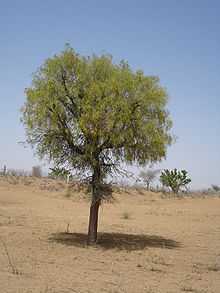Prosopis cineraria
| Prosopis cineraria | |
|---|---|
 | |
| Scientific classification | |
| Kingdom: | Plantae |
| (unranked): | Angiosperms |
| (unranked): | Eudicots |
| (unranked): | Rosids |
| Order: | Fabales |
| Family: | Fabaceae |
| Genus: | Prosopis |
| Species: | P. cineraria |
| Binomial name | |
| Prosopis cineraria (L.) Druce | |
| Synonyms | |
|
Adenanthera aculeata Roxb.[1] | |
Prosopis cineraria is a species of flowering tree in the pea family, Fabaceae. It is native to arid portions of Western Asia and the Indian Subcontinent, including Afghanistan, Iran, India, Oman, Pakistan, Saudi Arabia, the United Arab Emirates, and Yemen. It is an established introduced species in parts of Southeast Asia, including Indonesia.[1] Common names include Ghaf (Arabic);[2] Khejri or "Loong Tree" [3](Rajasthan); Janty(जांटी) (Bishnois); Jand[1] (Punjabi); Kandi (Sindh); Banni (Kannada);Gandasein(Burmese); Vanni (Tamil); Jammi (Telugu); Chaunkra,[1] Jant/Janti, Khar,[1] Khejri/Khejra,[1] Sami, Shami (Marathi)and (Hindi);[4] Sumri (Gujarat); Vanni-andara, Katu andara, Kalapu andara, Lunu andara (Sinhala).
It is the state tree of Rajasthan (India. A large and well known example of the species is the Tree of Life in Bahrain – approximately 400 years old and growing in a desert devoid of any obvious sources of water.
It is also the national tree of the United Arab Emirates. Through the Give a Ghaf campaign its citizens are urged to plant it in their gardens to combat desertification and to preserve their country's heritage.[5] In Sri Lanka the mesquite Prosopis juliflora native to Central and South America is also known as katu andara. It was introduced in 1880 and has become a serious problem as an invasive species.[6]
Description

P. cineraria is a small tree, ranging in height from 3 – 5 m. Leaves are bipinnate, with 7 – 14 leaflets on each of 1 – 3 pinnae. Branches are thorned along the internodes. Flowers are small and creamy-yellow, and followed by seeds in pods. The tree is found in extremely arid conditions, with rainfall as low as 150mm annually; but is indicative of the presence of a deep water table. As with some other Prosopis spp., P. cineraria has demonstrated a tolerance of highly alkaline and saline environments.[7]
Uses
The wood of P. cineraria is a good fuel source, and provides excellent charcoal plus firewood, fodder, green manure and goat-proof thorny fences.[4][7][8]
The leaves, called "Loong" in India and pods are consumed by livestock and are a beneficial forage.[4][7] In Rajasthan, India, P. cineraria is grown in an agroforestry setting in conjunction with millet.[7] The tree is well-suited for an agroforestry setting, because it has a single-layered canopy, it is a nitrogen fixer (thus enriching the soil), and its deep roots avoid competition for water with crops.[4]
Khejari fruits or pods are locally called sangar or sangri. The dried pods locally called Kho-Kha are eaten. Dried pods also form rich animal feed, which is liked by all livestock. Green pods also form rich animal feed, which is prepared by drying the young boiled pods. The dried green sangri is used as a delicious dried vegetable which is very costly (Nearly Rs.400 per kg in market). Many Rajasthani families use the green and unripe pods (sangri) in preparation of curries and pickles.[9]
See also
References
- ↑ 1.0 1.1 1.2 1.3 1.4 1.5 1.6 "Prosopis cineraria (L.) Druce". Catalogue of Life. Integrated Taxonomic Information System and Species2000. 2012-03-15. Retrieved 2012-03-21.
- ↑ 2.0 2.1 "Prosopis cineraria (L.) Druce". Germplasm Resources Information Network. United States Department of Agriculture. 2006-01-27. Retrieved 2009-12-31.
- ↑ Rejuvenation of Khejri Trees through Bio-control Agents
- ↑ 4.0 4.1 4.2 4.3 "Prosopis cineraria". AgroForestryTree Database. World Agroforestry Centre. Retrieved 2012-03-21.
- ↑ Philp, Myra (17 June 2013). "UAE groups help to save ghaf trees on UN 'Combat Desertification Day'". 7DAYS in Dubai (Al Sidra Media). Retrieved 11 September 2013.
- ↑ Gunasekera, Lalith (6 December 2011). "Will Katu-andara Destroy the Biodiversity of Bundala Wet Land?". The Sri Lanka Guardian. Retrieved 11 September 2013.
- ↑ 7.0 7.1 7.2 7.3 "Prosopis cineraria (L.) Druce". Tropical Forages. Centre for International Agriculture Research and Food and Agriculture Agency. 2005. Retrieved 2012-03-21.
- ↑ The Secret Life of Trees, by Colin Tudge. Penguin Books. ISBN 975-0-14-101293-3.
- ↑ "Kijri -Prosopis cineraria".
External links
| Wikimedia Commons has media related to Prosopis cineraria. |